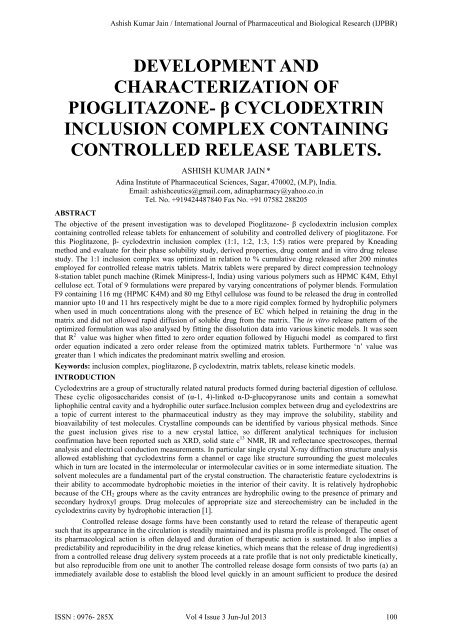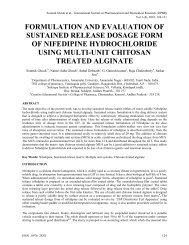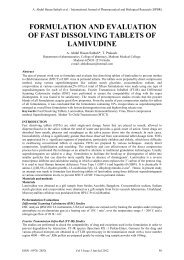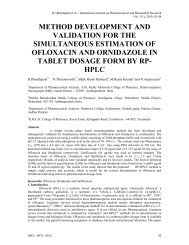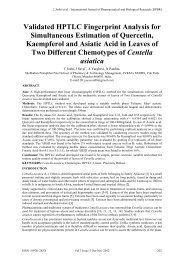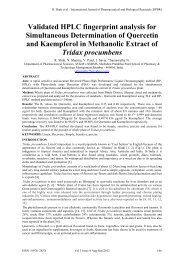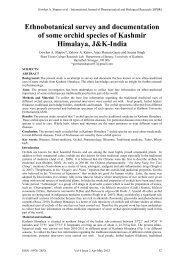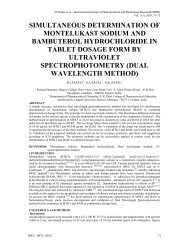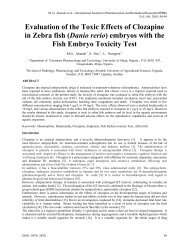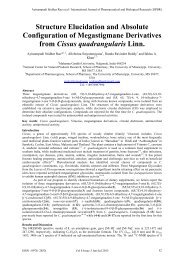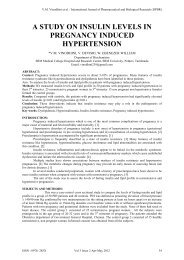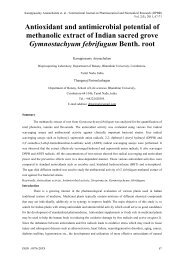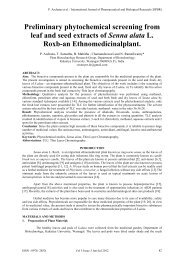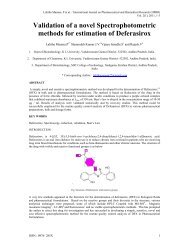β CYCLODEXTRIN INCLUSION COMPLEX CONTAINING ...
β CYCLODEXTRIN INCLUSION COMPLEX CONTAINING ...
β CYCLODEXTRIN INCLUSION COMPLEX CONTAINING ...
- No tags were found...
Create successful ePaper yourself
Turn your PDF publications into a flip-book with our unique Google optimized e-Paper software.
Ashish Kumar Jain / International Journal of Pharmaceutical and Biological Research (IJPBR)< 0.15 Cs, the equation becomes Dq / dt = K 1 C s or an integrated form Ln q0/q t = k 1 t where, qt = amount drugreleased per unit surface area, k 1 = 1 st order release rate constant, q 0 = Initial amount, Cs = Saturation stability,Ct = concentration at time ‘t’. The plots of log % amount remaining to be released vs time of differentformulations are given the Figures 9. The R 2 (regression) values and rate constants of all the formulations aredepicted in the Table 9.Hixon -Crowell Kinetic ModelAs solid dissolved, the surface area changed with time. The Hixon-Crowell cube root equation for dissolutionkinetics is based on the assumption that a) Dissolution occurs normal to the surface area of the particles. b)Agitation is uniform on overall exposed surface and there is no stagnation. The particles of solute retain itsgeometric shape. c) For a non-dispersible powder with spherical particles a bit mathematical derivation leads tothe kinetics equation: W 1/3 1/3o - W t = K Hc t where, W o = Initial weight of the particles, W t = Weight of theparticle at‘t’, K HC = Hixon - Crowell release rate constant and t = timeHiguch kinetic ModelFor a coated or matrix type dosage form, the dissolution medium enters the dosage form in order the drug to bereleased by diffusion. In such cases, the dissolution follows the equation by Higuchi. Q = Or Q = K HG t 0.5Where, Q = Amount of drug released per unit area of the dosage form. D = Diffusion coefficient of the drug. E= Porosity of the matrix. A = Area C s = Saturation solubility of the drug in the surrounding liquid. K HG =Higuchi Release rate constant. t = time. The cumulative % amounts of drug released with respect to square rootof time of various formulations are given in the Tables 10.Korsemeyer -Peppas kinetic ModelKorsmeyer developed a simple Semi empherieal model, relating exponentially the drug release to the elapsedtime, which was verified by Peppas & Franson, The model relates the fractional release with potency time anddescribed as. M t / M = K m t n . Log M t /M = log k m + n log t. Where, M t /M = Fraction release of drug. t =Release time. K m = Constant incorporating geometric and structural characteristics of release device. n = releaseexponent indicative of release mechanism. If one plot the logarithm of the fractional release Vs the logarithmtime then the slope of the graph gives the values of ‘n’. An analysis of diffusional drug release usingKorsemeyer - Peppas is shown in the Table 11.COMPARATIVE EVALUATION OF DISSOLUTION PROFILESLog % amount of drug released with respect to the log time of different formulation are given in the Table12.The n (release exponent) values are given in the Table13.RESULTS AND DISCUSSIONSPioglitazone is an important drug belonging to antidiabetic category. It is poorly soluble in water and hence itsimprovement of solubility and rate of dissolution are important. Thus an attempt was made to increase thesolubility of drug by preparing it in a solid dispersion form and by forming inclusion complexes of the drug withcyclodextrins. The solubility of pure drug and phase solubility of pioglitazone in β-CD solution was conductedand it was found that solubility of drug was increased with β-CD. Phase solubility diagrams of pioglitazone andβ-CD complexes can be classified as A L type of phase solubility curve According to Higuchi and Conners.Because the straight line has slope less than unity, the increase in solubility was due to the formation of 1:1 Mcomplex. The apparent solubility constant obtained from the slope of phase solubility diagram was found to be102.36 M -1 for Pioglitazone and β-CD complexes. The values of stability constant indicated that the pioglitazone-β-CD complexes formed are adequately stable. The phase solubility curve was shown in Figure 4.The inclusion complexes of Pioglitazone and β-CD were prepared in different molar ratios (1:1, 1:2,1:3, 1:4) by kneading method. Physical mixtures of pioglitazone and β-CD in the above said molar ratios werealso prepared. Drug content was estimated for the prepared complexes and physical mixtures (Table7).Dissolution profiles of pure pioglitazone, physical mixtures of pioglitazone- β-CD and pioglitazone- β-CDinclusion complexes were determined. The % CDR values are shown in (Table -4) and the plots of comparativedissolution profile was shown in (Figure 5 and 6). It can be seen that after 15 minutes only 0.15 % pure drug isdissolved and even after 45 minutes only 8.19 % drug goes into solution where as in case of Pioglitazone and β-CD inclusion complex prepared by kneading method in a 1:1 molar ratio 26.44 % drug was released within 15minutes and almost complete release (99.12 %) was seen after 45 minutes. Hence it can be said that inclusioncomplexes showed higher dissolution than the pure drug .Thus the solubility was increased by complexationwith β-CD.Matrix tablets were prepared by direct compression technology using various polymers such as HPMCK4M, Ethyl cellulose. Total of 9 formulations were prepared by varying concentrations of polymer blends. Theformulations were evaluated for various quality control tests. All the formulations were found to be satisfactoryand reproducible as observed from the data in (Table 7). Tablet hardness was found to be good (between 4.5-6kg/cm 2 ) depending compression force applied and friability was less than 0.6 %.ISSN : 0976- 285X Vol 4 Issue 3 Jun-Jul 2013 104
Ashish Kumar Jain / International Journal of Pharmaceutical and Biological Research (IJPBR)Formulation F1 containing 16 % of HPMC K4M and EC (18 cp) showed 89.01 % release within 8 hrsof dissolution study. Formulation F2 and F3 containing 40 % and 46 % of only HPMC K4M showed 99.45 %and 99.32 % release within 9 hrs and 10 hrs respectively. The drug release was slower from the aboveformulations. But no significant difference in release rate was observed for tablets containing either 40 % or 46% of only EC in formulation F4 and F5. In F6 and F7 20 % of HPMC K4M was used in combination with 24 %and 30.6 % of EC respectively but the drug release was controlled only for 7 hrs. But when 26.5 % and 32.7 %of HPMC K4M was used in combination with 24 % and 30.6 % of EC in F8 and F9 the release was controlledupto 10 and 11 hrs respectively. This may be due to a more rigid complex formed by hydrophilic polymers(HPMC K4M) when used in much concentrations along with the presence of EC which helped in retaining thedrug in the matrix and did not allowed rapid diffusion of soluble drug from the matrix. Hence the F9formulation was the best formulation based on controlling the release rate for 11 hours. The invitro releasepattern of the optimized formulation was analysed by fitting the dissolution data into various kinetic models. Itwas seen that R 2 value was higher when fitted to zero order equation (Table-28 and Figure 7) followed byHiguchi model (Figure 11) as compared to first order equation (Figure 10) which indicated a zero order releasefrom the optimized pioglitazone matrix tablets. As the n value for formulation was greater than 1 whichindicates the predominant matrix swelling and erosion.CONCLUSIONPioglitazone is an antidiabetic drug which is poorly soluble in water. Solubility of pioglitazone was enhanced bypreparing complexes with β-CD. A L type of phase solubility curve was seen when pioglitazone was complexedwith β-CD. Inclusion complexes formed with β-CD have high solubility than corresponding physical mixturesand pure drug. Matrix tablets were prepared by using HPMC K4M and Ethyl cellulose (18 cp) by directcompression method. All the prepared tablets were evaluated for weight variation, friability, hardness, diameter,drug content & drug release pattern. The comparative evaluations of the dissolution profiles were done. “F9”was the best formulation based on drug release data. The in vitro release pattern of the optimized formulation(F9) was analysed by fitting the dissolution data into various kinetic models from which it was concluded thatformulation (F9) followed zero order release and the release mechanism was predominant matrix swelling anderosion.ACKNOWLEDGEMENTThe author Dr. Ashish K Jain thanks to the Adina Institute of Pharmaceutical Science, Sagar (M.P.) 470002India for providing facilities to carry out this project work. The authors thank to Aarati drugs Ltd, Aurangabad,India for supplying pioglitazone antidiabetic drug as a gift sample.DECLARATION OF INTERESTThe authors report no conflicts of interest. The authors alone are responsible for the content and writing of thisarticle.REFERENCES[1] Peri D, Wandt CM, Cleary RW, Hikal AH, Jones AB. Complexes withbeta-cyclodextrin and hydroxypropyl beta-cyclodextrin.Drug Devel and Ind Pharm 1994; 20:1401-1410.[2] Lachman L, Liberman HA, Kanig JL. The theory and practice of Industrial Pharmacy. 3rd ed. Philadelphia: Lea and Febiger; 1987.[3] Lee VH and Robinson JR. Sustained and controlled release drug delivery systems. 1st ed. New York: Marcel Dekker; 1989.[4] Lapidus J, Lordi NG. Drug release from compressed hydrophilic matrices. J Pharm Sci 1968; 57:12921301.[5] Higuchi T. Mechanism of sustained action medication. Theoretical analysis of rate of release of solid drugs dispersed in solidmatrices. J Pharm Sci 1963; 52: 1145-1149.[6] Costa P, Lobo JMS. Modeling and comparison of dissolution profiles. Euro J Pharm Sci 2001; 13: 123-133. Ashoka V, Bhosle RV.Tukawale S, Sawant D. Oral Novel Drug Systems. The Eastern Pharmacist 2000; 3: 41-43.[7] Chowdary KP, ReddyK. Complexes of nifedipine with beta-cyclodextrin and hydroxypropyl beta-cyclodextrin in the design ofnfedipine SR tablets. Ind J Pharm Sci 2002; 64: 142.[8] Colomba P, Bettini, Manima R. An overview of hypoglycemic agent. J Pharm Sci 1991; 86: 8-19.CAPTIONS AND LEGENDSFigure 1. Plasma drug concentration profiles for conventional formulation, a sustained release formulation anda zero order controlled release formulation.Figure 2. Schematic representation of matrix release systemFigure 3. pH Solubility graph of pioglitazoneFigure 4. Phase solubility curve of pioglitazone and β-CDFigure 5. Dissolution profiles of physical mixturesFigure 6. Dissolution profiles of inclusion complexes.Figure 7. Zero order release profiles of formulationsFigure 8. Zero order release profiles of formulation F9.Figure 9. First order release profiles of formulationsFigure 10. First order release profiles of formulation F9.ISSN : 0976- 285X Vol 4 Issue 3 Jun-Jul 2013 105
Ashish Kumar Jain / International Journal of Pharmaceutical and Biological Research (IJPBR)Figure 11. Higuchi release profiles of formulationsFigure 12. Higuchi release profiles of formulation F9.Figure 13. Korsemeyer- peppas release profiles of formulationsFigure 14. Korsemeyer- peppas release profiles of formulation F9Table 1: Solubility values of pioglitazone in different pH rangesTable 2. Concentration of β-CD and pioglitazone.Table 3. Drug content percentage of physical mixtures (PM) and kneaded complex (KC)Table 4. % Cumulative pioglitazone release from Physical mixtures and Kneaded Complex.Table 5. Physico-chemical Properties of Powdered MixturesTable 6. Formulation of pioglitazone CR Tablets using HPMC K4M and Ethyl celluloseTable 7. Physico-Chemical Properties of Prepared TabletsTable 8. Log % ADR from the formulations using HPMC K4M and Ethyl celluloseTable 9. % CDR from the formulations using HPMC K4M and Ethyl celluloseTable 10. Cumulative % of drug released from the formulations using HPMC K4M and Ethyl celluloseTable 11. Log % CDR from the formulations using HPMC K4M and Ethyl celluloseTable 12 . Release kinetics of pioglitazone from optimized matrix tabletTable 13. Interpretation of diffusional drug release from hydrophilic matrix tablets.Table 14. Regression analysis of different release kineticsTimeFigure 1. Plasma drug concentration profiles for conventional formulation, a sustained release formulation and a zero order controlledrelease formulation.CBAErosion frontDiffusion frontSwelling frontFigure 2. Schematic representation of matrix release systemISSN : 0976- 285X Vol 4 Issue 3 Jun-Jul 2013 106
Ashish Kumar Jain / International Journal of Pharmaceutical and Biological Research (IJPBR)pH Solubility profile of pioglitazonesolubility(μg/ml)1510500 2 4 6 8pHFigure 3. pH Solubility graph of pioglitazoneFigure 4. Phase solubility curve of pioglitazone and β-CDComparative dissolution profile of pioglitazone β-CDphysical mixturecumulative %drugrelease1201008060402000 50 100 150 200time(min)1:1 1:2 1:3 1:5 pure drugFigure 5. Dissolution profiles of physical mixturesISSN : 0976- 285X Vol 4 Issue 3 Jun-Jul 2013 107
Ashish Kumar Jain / International Journal of Pharmaceutical and Biological Research (IJPBR)%CDR120100806040200Comparative dissolution profile of pioglitazone β-CD inclusion complex0 50 100 150 200Time (min)1:1 1:2 1:3 1:5 Pure drugFigure 6. Dissolution profiles of inclusion complexes.Cumulative %drug releaseCumulative % drug release profile offormulations(F1-F9)1201008060402000 5 10 15F1F2F3F4F5F6F7F8F9time(hr)Figure 7. Zero order release profiles of formulationsCumulative % drug release profile of F9120cumulative %drugrelease100806040200-200 5 10 15time (hr)Figure 8. Zero order release profiles of formulation F9.ISSN : 0976- 285X Vol 4 Issue 3 Jun-Jul 2013 108
Ashish Kumar Jain / International Journal of Pharmaceutical and Biological Research (IJPBR)First order release profile offormulation (F1-F9)log %adr2.521.510.500 5 10 15time(hr)F1F2F3F4F5F6F7F8F9Figure 9. First order release profiles of formulationsFirst order release profile of F9log % ADR2.521.510.500 5 10 15time (hr)Figure 10. First order release profiles of formulation F9.cumulative %drug release120100806040200Higuchi release profiles offormulations(F1-F9)0 1 2 3 4F1F2F3F4F5F6F7F8F9sq. root of timeFigure 11. Higuchi release profiles of formulationsISSN : 0976- 285X Vol 4 Issue 3 Jun-Jul 2013 109
Ashish Kumar Jain / International Journal of Pharmaceutical and Biological Research (IJPBR)Higuchi release profile offormulation F9cumulative %drugrelease150100500-500 1 2 3 4sq root of timeFigure 12. Higuchi release profiles of formulation F9.log cumulative %of drug released2.521.510.50-0.5Korsemeyer- peppas release profileof formulations(F1-F9)0 0.5 1 1.5log timeF1F2F3F4F5F6F7F8F9Figure 13. Korsemeyer- peppas release profiles of formulationsKorsemeyer- peppas release profileof F9log %CDR2.521.510.500 0.5 1 1.5log timeFigure 14. Korsemeyer- peppas release profiles of formulation F9ISSN : 0976- 285X Vol 4 Issue 3 Jun-Jul 2013 110
Ashish Kumar Jain / International Journal of Pharmaceutical and Biological Research (IJPBR)Table 1: Solubility values of pioglitazone in different pH rangespHSolubility(μg/ml)4.9 9.116.8 3.817.2 3.43Table 2. Concentration of β-CD and pioglitazone.S. No. Conc. of β-CDConc of Pioglitazone(mM / L)(mM / L)1 0.04 0.01692 0.06 0.018073 0.08 0.018224 0.1 0.019825 0.2 0.03497Table 3. Drug content percentage of physical mixtures (PM) and kneaded complex (KC)S. No. Pioglitazone: β-CD Ratio % Pioglitazone ContentPMKC1. 1:1 86.23 88.762. 1:2 82.29 85.613. 1:3 77.24 79.824. 1:5 75.36 78.02ISSN : 0976- 285X Vol 4 Issue 3 Jun-Jul 2013 111
Ashish Kumar Jain / International Journal of Pharmaceutical and Biological Research (IJPBR)Table 4. % Cumulative pioglitazone release from Physical mixtures and Kneaded Complex.S.No.Time(min)PureDrug%CDR% Cumulative drug ReleasePhysical mixtureKneaded Complex1:1 1:2 1:3 1:5 1:1 1:2 1:3 1:51. 150.15 15.61 5.41 15.92 10.97 0.15 26.44 5.10 22.112. 301.70 58.29 27.98 26.44 24.58 1.70 91.08 41.28 92.013. 458.19 75.92 39.12 45.36 37.26 8.19 99.12 76.23 97.274. 6021.80 91.08 56.14 57.98 56.13 21.80-98.50-5. 7537.57-77.16 77.16 62.62 37.57- - -6. 9045.61-94.48 87.68 85.20 45.61- - -7. 10558.29- - - -58.29- - -8. 12072.83- - - -72.83- - -9. 13587.06- - - -87.06- - -10. 15098.19- - - -98.19- - -11. 165 - - - - - - - - -12. 180 - - - - - - - - -Table 5. Physico-chemical Properties of Powdered MixturesFormulation No.Bulk densityn = 3Tapped densityn = 3Carr’sIndex%Hausner’sratioAngle of reposen = 3F1 0.412 0.007 0.48 0.02 16.99 1.16 29.32 0.24F2 0.44 0.006 0.49 0.008 10.20 1.11 30.20 0.28F3 0.46 0.005 0.530.0007 15.21 1.15 31.05 0.25F4 0.415 0.005 0.48 0.011 14.4 1.156 32.31 0.22F5 0.46 0.015 0.51 0.009 10.86 1.109 30.09 0.88F6 0.43 0.01 0.496 0.014 15.34 1.153 31.46 0.10F7 0.439 0.003 0.489 0.008 11.38 1.11 30.58 0.33F8 0.433 0.011 0.51 0.012 17.78 1.18 31.26 0.33F9 0.429 0.006 0.497 0.007 15.85 1.158 32.15 0.40ISSN : 0976- 285X Vol 4 Issue 3 Jun-Jul 2013 112
Ashish Kumar Jain / International Journal of Pharmaceutical and Biological Research (IJPBR)Table 6. Formulation of pioglitazone CR Tablets using HPMC K4M and Ethyl celluloseIngredientsPioglitazoneHPMC K4MEthyl celluloseMCCMagnesiumstearateTotal weightQuantity of Ingredient / Tablet (mg)Batch NumberF1 F2 F3 F4 F5 F6 F7 F8 F9116 116 116 116 116 116 116 116 11640 100 115 - - 50 50 65 8040 - - 100 115 60 75 60 7545 25 25 25 25 25 25 15 054 4 4 4 4 4 4 4 4245 245 260 245 260 255 270 270 280Table 7. Physico-Chemical Properties of Prepared TabletsFormulation No.Avg. Wt. (mg)n = 20Hardness(kg/cm2 )n = 10Diameter(cm)n = 10Drug Content (%) n= 10Friability (%)n=10F1 246.236.210 5.50.324 7.940.053 99.3142.024 0.553F2 244.365.891 6..00.356 7.930.05 99.642.055 0.542F3 259.516.113 5.00.405 7.980.044 100.042.271 0.573F4 245.1626.035 5.50.398 7.970.049 99.0252.054 0.549F5 259.486.148 5.00.28 7.980.051 99.1452.144 0.562F6 256.856.349 4.50.336 7.960.044 99.371.991 0.583F7 268.636.413 6.00.225 7.950.047 98.7742.191 0.539F8 269.376.717 5.50.278 7.970.047 98.732.12 0.561F9 278.296.601 5.00.356 7.960.049 98.832.05 574* mean (n=3)ISSN : 0976- 285X Vol 4 Issue 3 Jun-Jul 2013 113
Ashish Kumar Jain / International Journal of Pharmaceutical and Biological Research (IJPBR)Table 10. Cumulative % of drug released from the formulations using HPMC K4M and Ethyl celluloseS. No. Time(hr)%CDRof F1%CDRof F4%CDRof F5%CDRof F6%CDRof F7%CDRof F8%CDRof F9%CDRof F2%CDRof F31 0 0 0 0 0 0 0 0 0 02 0.5 0.69 1.31 1.01 1.01 2.40 1.16 1.93 0.54 0.853 1 5.6 6.42 5.49 10.28 12.14 6.26 7.96 4.71 3.324 2 12 18.63 18.02 19.72 18.79 16.31 18.32 13.69 10.905 3 18.32 19.84 18.68 23.26 20.35 17.69 20.24 15.25 11.036 4 24.20 22.12 21.86 29.49 28.92 22.31 26.12 18.43 21.27 5 30.97 27.27 26.48 42.01 46.29 36.99 42.59 22.51 25.18 6 46.90 33.33 33.43 59.74 71.03 58.31 64.82 28.20 32.239 7 65.35 48.72 44.51 86.09 98.46 86.10 94.04 40.18 40.0410 8 89.01 69.15 59.73 - - - - 54.14 50.1411 9 - 99.45 77.82 - - - - 70.25 57.7703312 10 - - 99.32 - - - - 87.45 73.884113 11 - - - - - - - - 97.514 12 - - - - - - - - -Table 11. Log % CDR from the formulations using HPMC K4M and Ethyl celluloseS.No.LogtimeLog%CDRof F1Log%CDRof F2Log%CDRof F3Log%CDRof F4Log%CDRof F5Log%CDRof F6Log%CDRof F7Log%CDRof F8Log%CDRof F91 0 0 0 0 0 0 0 0 0 02 - - 0.117 0.002 0.002 0.379 0.064 0.286 - -3 0 0.74 0.807 0.74 1.012 1.084 0.796 0.901 0.673 0.5224 0.301 1.079 1.27 1.256 1.295 1.274 1.212 1.263 1.136 1.0385 0.477 1.263 1.298 1.271 1.367 1.308 1.248 1.306 1.183 1.0426 0.602 1.384 1.345 1.339 1.47 1.461 1.349 1.417 1.265 1.1247 0.699 1.491 1.436 1.423 1.623 1.666 1.568 1.629 1.352 1.2368 0.778 1.671 1.523 1.524 1.776 1.851 1.766 1.812 1.45 1.3639 0.845 1.815 1.688 1.65 1.935 1.99 1.935 1.973 1.604 1.50310 0.903 1.949 1.84 1.776 - - - - 1.734 1.63811 0.954 - 1.997 1.89 - - - - 1.847 1.76112 1 - - 1.997 - - - - 1.942 1.86913 1.041 - - - - - - - - 1.9714 1.079 - - - - - - - -ISSN : 0976- 285X Vol 4 Issue 3 Jun-Jul 2013 115
Ashish Kumar Jain / International Journal of Pharmaceutical and Biological Research (IJPBR)Table 12 . Release kinetics of pioglitazone from optimized matrix tabletFormulations Zero-order First-order Higuchi Korsemeyer-PeppasTable 13. Interpretation of diffusional drug release from hydrophilic matrix tablets.Releaseexponent(n) valuesF1 0.924 0.7261 0.8349 0.972 1.28F2 0.861 0.7967 0.7665 0.906 1.66F3 0.909 0.786 0.8159 0.933 1.12F4 0.927 0.750 0.856 0.937 1.015F5 0.898 0.589 0.809 0.873 1.035F6 0.887 0.714 0.797 0.925 1.235F7 0.899 0.658 0.810 0.927 1.176F8 0.913 0.740 0.816 0.942 1.164F9 0.9602 0.801 0.847 0.933 1.29Release Exponent (n) Drug transport mechanism Rate at function of time 0.5 Fickian diffusion t 0.50.5 < n < 1 Non Fickiandiffusion/Anomolus transportt n-11.0 Case II transport Zero order releaseHigher than 1.0 Super case – II transport t n-1Table 14. Regression analysis of different release kineticsRelease order/modelR(coefficient of correlation)Zero order release model 0.960First order release model 0.801Higuchi model 0.847ISSN : 0976- 285X Vol 4 Issue 3 Jun-Jul 2013 116


